Tibet Railway
Tibet Railway, since the operation on July 1st, 2016, has become one of the busiest railways in Asia. As the only railway connecting Tibet with the outside world, Tibet railway, also known as the Qinghai Tibet Railway, is not only take the local Tibet Tibetans out of the plateau, where they have been living for centuries, but also bring millions of travelers from all over the world to experience the holy land on the snowfields.
In the full length of 1,956 kilometers, there are 960 kilometers of Tibet Railway above sea level above 5,000 kilometers. There is no doubt that the Tibet railway is the world’s highest railway, and the whole construction of the Tibet railway also broke numerous world records.
While traveling along the great railway to Tibet, you will enjoy kinds of a stunning view of the Tibet plateau. For passengers enjoy the scenery better, there are some scenic stations en route, where you can get off the train and enjoy the marvelous landscape around.
Though it is the highest railway in the world, you don’t need to worry too much about the altitude sickness onboard. All Tibet trains are specially designed with an oxygen supply system.
Currently, there are seven cities offers trains to Tibet in mainland China, including Beijing, Shanghai, Guangzhou, Chengdu, Xining, etc. It is quite convenient to take a train to Tibet from mainland China. But it is suggested to book the train ticket in advance, for it is really a popular way of getting to Tibet.
In the future, there will be more railways to Tibet as the extension of the recent Qinghai Tibet railway, such as the China Nepal railway from Lhasa to Kathmandu, and the railways connecting Tibet with Sichuan, Yunnan, and Xinjiang.
How to book your Tibet train ticket and fulfill your dream to travel through the Qinghai Tibet railway? Here is the most comprehensive information about Tibet railway with the ultimate guide to arrange a Tibet train tour.
CONTENT
Fact of Qinghai Tibet Railway
Qinghai Tibet Railway Project Construction
Construction on the Qinghai Tibet Railway project began on June 29, 2001, flowing a 17-year gap between completion of the section from Xining to Golmud and the start of the remainder of the railway line.
This was mainly due to the technical difficulties the railway engineers faced with building a railway line over high mountains and across the vast Tibetan plateau’s permafrost ground.
The track laying project began at the location of the Amdo Railway Station, which was the main construction yard for the line, and ran in both directions, towards Tanggula Mountain and towards Lhasa, at the same time.
Records of Tibet Railway
The Tibet railway, which was one of the most daring projects in the world at the time, has since broken numerous world records, including the record for the World’s Highest Railway.
With its highest point at the Tangla Pass, at 5,072 meters, the railway overtook the previous highest railway line, the Lima-Huancayo Railway in Peru, which sat at a height of 4,781 meters above sea level at its highest point.
But that was not the only record this unique high-altitude railway broke.
According to the Guinness Book of World records, the railway also holds the records for:
The world’s highest tunnel (Fenghuoshan) at 4,905 meters
The world’s highest railway station (Tanggula Mountain Station) at 5,072 meters
The world’s longest plateau railway at 1,956 kilometers
The world’s longest plateau tunnel built on permafrost (Kunlun Mountain Tunnel) at 1,686 meters
The world’s highest construction site (Amdo Construction Site) at 4,704 meters above sea level.
Eco-environment Protection
The Qinghai Tibet Railway runs through three important ecological areas on its route from Qinghai to Lhasa, and the construction of the railway had the ecological impact on the plateau in mind when it was building the tracks.
The rail route across the plateau took into account the fragile environment of the plateau, and the route was designed to detour and avoid areas of major ecological impact.
Wildlife experts and ecological experts were employed to ensure that the tracks had a minimal impact on the environment and the local wildlife, and where it could not be avoided; bridges were constructed over the traditional migration routes of the plateau animals, so that the trains would not interfere with their normal habits.
Engineering Challenges
The technical difficulties of building a railway across the high-altitude plateau were many and varied, including the construction of tracks over semi-permanent permafrost ground and the rise of the tracks to altitudes never before reached, such as the Tangla Pass.
With the hardest part being the fact that the heat of the trains crossing the plateau may increase the melt of the permafrost, engineers built the tracks on elevated sections, driving foundations deep into the ground and lifting the tracks above the permafrost, thus keeping the ground at its normal temperature.
Scenes along Qinghai Tibet Railway
There are a huge number of sights along the line of the Qinghai Tibet Railway that are some of the most stunning sights on the plateau. In areas that most travelers to Tibet never visit, the Tibet train tour takes tourists into parts of Tibet that they would not normally see.
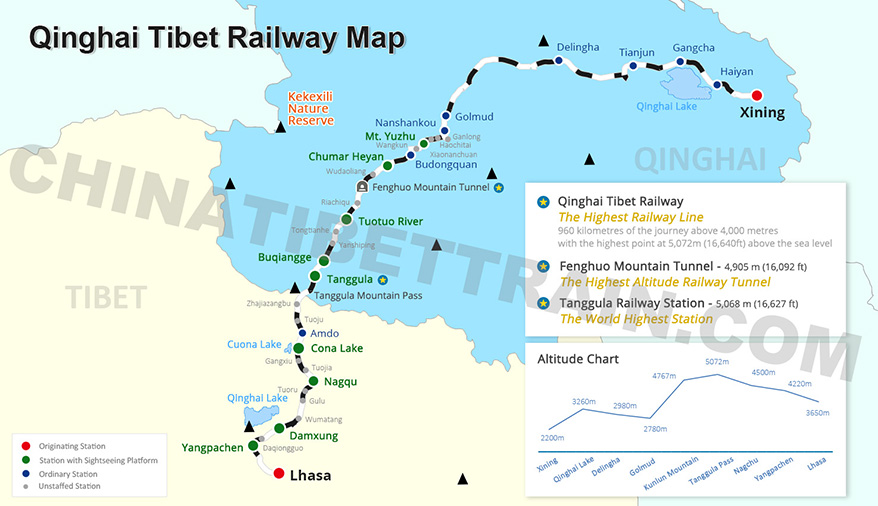 Detailed Qinghai Tibet Railway Map
Detailed Qinghai Tibet Railway MapHighlights along the Qinghai Tibet Railway
The first is the Qinghai Lake, the largest saltwater lake in China, with its Bird Island on the western shore, a paradise for a huge variety of local and migrant birds. It lies to the north of the railway, just outside Xining. At an altitude of 3,205 meters above sea level, it is one of the first amazing sights of this awesome journey.
Kekexili Nature Reserve, also known as Hoh Xil, is the largest nature reserve in China, covering an immense 45,000 square kilometers of grasslands between the Kunlun Mountains in Qinghai Province and Tibet. At an altitude of around 4,700 meters, it is a home to more than 100 species of rare and endangered species, including the rare Tibetan Antelope, the wild donkey, and the cute Pika.
The Tanggula Mountains mark the highest point of the Qinghai Tibet Railway, at the Tanggula Mountain Railway Station, which lies at an altitude of 5,068 meters and is now the world’s highest railway station. The mountain range lies in the central plateau region of the Tibetan plateau, and form the boundary between Qinghai Province and the Tibet Autonomous Region.
The largest expanse of grasslands in China, the Changtang Grasslands extend from Qinghai province in the east to the Indian state of Ladakh in the west, crossing the entire northern area of the plateau. A vast highlands region that is covered in lakes, both large and small, it is the home to the nomadic Tibetan Changpa people.
Cona Lake, also known as Tsonag Lake, lies in the Amdo County area of Nagqu, in Northern Tibet, and is considered to be one of the most sacred lakes in the ancient Tibetan Bon religion. At 4,594 meters above sea level, it is one of the world’s highest freshwater lakes, and lies close to the railway lines between Nagqu Town and Amdo Town.
Different Highlights of Tibet Railway in Different Seasons
Spring
The spring scenery in Tibet along the line of the tracks is one of new growth and fertile landscapes. Spring is not the peak season for Tibetan tourism, so few people come to the plateau in April, but this is when the landscape is at one of its most beautiful times. The skies are bright and the snow-capped mountains dazzle in the sunlight, standing tall against the clear blue skies.
Summer
In summer, the scenery changes dramatically, as the rains come across the plateau, making the landscape greener and more verdant. The monsoon rains may not be heavy on this high-altitude plateau, but they still have the ability to refresh the flora of the region, and make it look lush and healthy. Throughout the summer months, the plateau is filled with greenery and wildlife.
Notice: Since summer holiday is a peak season as many domestic tourists also take trains to Tibet, it is suggested to book your Tibet train ticket as early as possible (suggested 30 days in advance).
Autumn
Autumn is the time when the leaves on the trees start to change color, and fall to the ground covering vast areas with a multi-colored carpet. Colorful flowers cover the grasslands as the summer draws to a close and the weather starts to cool down, with clear skies letting the sunlight dry up the lush landscape from the monsoon rains.
Notice: Try to avoid taking a train to Tibet in the period from late September to early October. During the national holiday in China, it is hard to get a Tibet train ticket, especially the Beijing Lhasa train ticket.
Winter
Winter may be a harsh time of year, but it is also one of the most beautiful, as the mountains are covered in fresh white snow, the skies are crisp and clear, and the weather, while a little cold, is fresh and bright. The high altitude sun allows the days to be warm, while the nights get cold, and as the lakes and rivers freeze, exotic patterns form in the surface ice. The plateau takes on a true “winter wonderland” look and feel, and it is one of the best times to be on Tibet for photography.
Landscape along the Qinghai-Tibet Railway (Shot in Winter, 2015)
Q: What are the scenery platforms along Tibet Railway?
The Qinghai Tibet Railway consists of 45 different stations along its length, though many of them are unmanned and trains rarely stop at them.
However, there are several stations that have “scenic platforms”, where passengers can get off for a few minutes and get a better view of the surrounding landscape for taking great photos.
The nine stations that have been set up with the scenic platforms are: Yuzhu Peak Station, Chumaer River, Tuotuo River, Buqiangge, Tanggula Mountain, Cuona Lake, Nagqu, Damshung, and Yambajan.
The platforms are around 500 meters long and stand an extra 1.25 meters above the platform, and trains that pass through in the daytime are scheduled to stop to allow the passengers to make the best use of these amazing features.
Major Railway Stations along Qinghai Tibet Railway
Xining Railway Station
The main railway station that serves the city of Xining in Qinghai Province, Xining Railway Station is the start of the Qinghai Tibet Railway which connects the city of Lhasa and the Tibetan plateau to the rest of China.
Delingha Railway Station
One of the first major stations on the Qinghai Tibet Railway after leaving Xining, Delingha Station lies on the northwestern edge of the Tibetan plateau and is one of the nine stations where almost every train to Tibet stops.
Golmud Railway Station
The main railway station for the town of Golmud, Golmud Station marks the start of the steep climb up to the high plateau, from the altitude of the station at 2,829 meters to the Kunlun Mountains.
When trains to Tibet pass Golmud Railway Station, the oxygen supply system onboard will start to work to pump the oxygen into the cabins to release the symptoms of high altitude sickness that passengers may get onboard.
Tanggula Railway Station
The world’s highest railway station, Tanggula Mountain Station lies at an altitude of 5,068 meters above sea level. Located just within the Tibet Autonomous Prefecture, the station lies just one kilometer from the highest point of the Qinghai Tibet Railway, the Tanggula Pass, which lies at 5,072 meters.
Amdo Railway Station
Believed to be the highest staffed railway station in the world (Tanggula Station is not staffed), Amdo Station lies at an altitude of 4,702 meters above sea level and is in the town of Pana, the seat of Amdo County in Nagqu.
Nagqu Railway Station
The second to last station you pass through on the trains to Lhasa, the station at Nagqu serves the prefecture-level city as its main railway station. The station at Nagqu is one of only three stations that have a crossing loop, where trains in opposite directions can pass through the station at the same time. There are also goods sidings for the freight trains that bring goods up to the plateau regularly.
Notice: Generally, the Tibet train stops over at Nagqu Railway Station for about 6 minutes. You can get off the train to take a deep breath of the fresh air of Tibet plateau and enjoy the scenery around the station.
Damxung Railway Station
The last station in the line before reaching Lhasa, Damxung Station lies close to Damquka, the county seat of Damxung County, in northern Lhasa. The station is ideally placed for those wishing to travel to Lake Namtso, one of the Great Three Holy Lakes of Tibet, which lies nearby.
Notice: Recently, only Xining to Lhasa Train Z6801 stops at Damxung Railway Station.
Lhasa Railway Station
The last stop for any train to Tibet, Lhasa Railway Station lies in the Doilungdeqen District of Lhasa, to the south of the Lhasa River. Around 5 kilometers from the center of Lhasa and the famous Potala Palace, the station sees up to five passenger trains a day stopping to drop off tourists and domestic passengers heading for the Tibetan capital.
Altitude Change of Qinghai Tibet Railway
From Xining to Lhasa, the altitude of Tibet railway raises from 2,275 meters to 3,650 meters at Lhasa, with the highest point at Tanggula Mountain Pass at 5,072 meters above the sea level.
Q: How to avoid altitude sickness when taking Tibet railway?
While riding the Qinghai Tibet Railway, there is actually a reduced chance of feeling the symptoms of altitude sickness, due mainly to the fact that, once the trains pass Golmud and start their climb up to the plateau, oxygen is pumped into the cars from the onboard oxygen supply system.
This makes the oxygen content of the train a little higher than that of sea level, and balances out the risk of getting altitude sickness that is caused by the thinner atmosphere and more widely spread oxygen in the air.
If you do feel the symptoms, you can speak to the onboard doctor, and get an oxygen tube from the train staff so that you can increase the oxygen intake with a personal supply line that connects to oxygen outlets all over the train.
More Tibet Railway Routes to/from Lhasa
According to the plan, there will be more railway lines connecting Tibet with surrounding areas in mainland China. Some of them are under construction, while others are still in the plan.
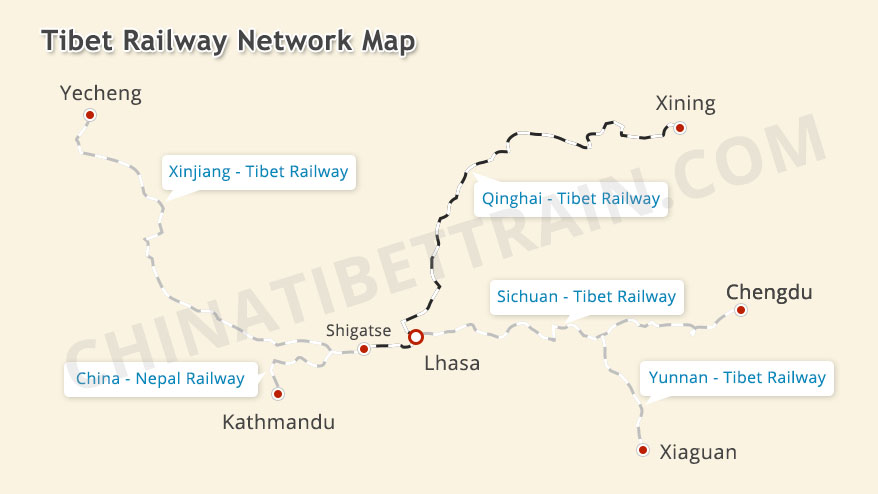 Tibet Railway Network Map
Tibet Railway Network MapChina Tibet Railway
Recently, there are six cities in mainland China served as the terminal stations for trains to/from Tibet, namely Beijing, Shanghai, Guangzhou, Chengdu, Chongqing, Xining, and Lanzhou.
Wherever you are in mainland China, you can easily get to one of those cities to take a train to Tibet.
Generally, there is only one train served in each city, please check the latest Tibet train schedule when planning your Tibet train tour.
Lhasa Shigatse Railway
An extension of the Qinghai Tibet Railway, and the first section of the planned Lhasa to Kathmandu Railway, the Lhasa Shigatse Railway runs from the capital’s large railway station to the station that has been built in Shigatse City, in Shigatse Prefecture.
There are fourteen stations along the 253-kilometer length of track, though only a few see regular passenger traffic. The line was opened for passengers in August 2014, and has become the main method of travel from the capital to Shigatse for local Tibetans.
>> Check the detailed information about Lhasa Shigatse Train.
China Nepal Railway
The extension of the Qinghai Tibet Railway, this planned route will run from Lhasa to Kathmandu, in a massive project that will extend the Lhasa Shigatse Railway another 628 kilometers across the border with Nepal and down into the Kathmandu Valley.
The China Tibet Nepal Railway is planned to be completed in 2022, and the latter part is still in the planning stages. The tracks will cross the Sino-Nepal border at the Gyirong Port border crossing.
Sichuan Tibet Railway
Another railway that is still under construction, once completed the Sichuan Tibet Railway will be the second railway from mainland China to Tibet.
Starting in the Sichuan provincial capital of Chengdu, and officially labeled as the Chuanzang Railway, the tracks are roughly following the G318 National Highway heading west through the mountains of western Sichuan and Nyingchi, to end in Lhasa.
Parts of the route have already been completed and opened, and the entire track is expected to open in around 2025, cutting the travel time to Tibet down to around eight hours.
Yunnan Tibet Railway
Proposed and planned, but not yet started, the Yunnan Tibet Railway, also known as the Dianzang Railway, will connect the city of Kunming in Yunnan Prefecture with the Sichuan Tibet Railway at Deqen and Markam.
Xinjiang Tibet Railway
The third proposed railway route into Tibet from mainland China, the Xinjiang Tibet Railway will connect the Xinjiang Uyghur Autonomous Prefecture with the city of Lhasa, and ultimately with the rest of China through a railway line that will run down along the western region of Tibet to join the proposed Sino-Nepal Railway at Shigatse.
Tibet Railway Ticket Price
There are three ticket classes on Tibet trains, including soft sleeper berths (first-class), hard sleeper berths (second-class), and the hard seats (third-class).
The Tibet train ticket cost varies depending on the station from which you depart to Tibet, and can change depending on the season as well.
Ticket prices in the summer months, which are the peak time for Tibetan tourism, are often more expensive than those in the winter months, due to demand and availability.
Tibet Railway Onboard Experience
The Tibet trains have all the facilities that you can expect from a long-distance train in China. There are two kinds of sleeping berths on Tibet trains, on which you can have a good sleep during the long journey. And through the big windows on Tibet trains, you can have a great view of the passing by the scenery in Tibet plateau.
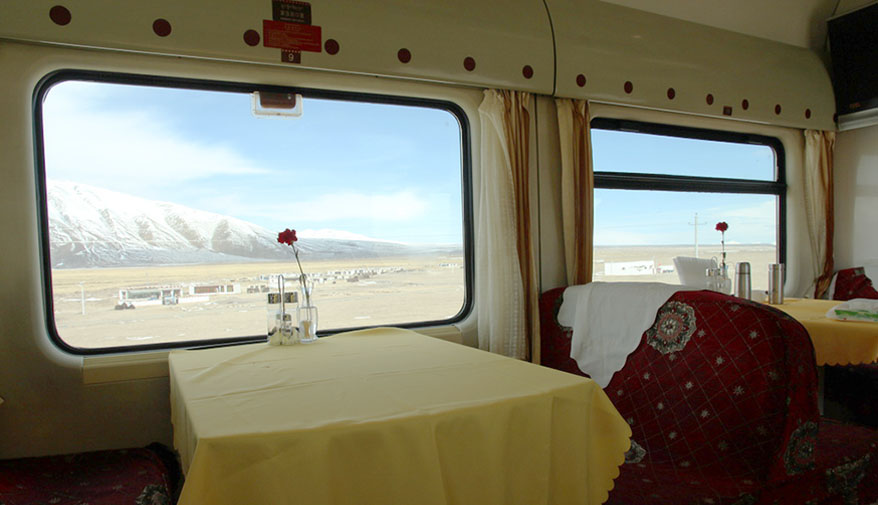 Enjoy the Stunning Landscape and Leisure Life on Tibet Trains
Enjoy the Stunning Landscape and Leisure Life on Tibet TrainsPassengers have a full washroom selection, with both Western and Chinese toilets, washing facilities at either end of each carriage, a full dining car that serves Chinese and Tibetan dishes, and a complete oxygen system for travelers that are feeling the effects of altitude sickness.
Passengers can also avail of the free boiling water on board the train, which is available at dispensers in every carriage, and there are trolleys that regularly run the length of the train serving hot meals and snacks.
>> Learn More about Tibet Train Facilities.
Q: How to kill time onboard Tibet Trains?
The best thing to do to pass the time on the trains, especially once they reach the Tibetan plateau after Golmud, is to watch the stunning landscapes which past out of the window.
The train passes through areas of the plateau that normal tourists are not permitted to enter, and it is a rare chance to see some of the most remote and beautiful areas of Tibet.
Alternatively, you can always bring a good book to read in the peace and tranquility of the train, or watch movies and listen to music. However, the view may just pull you away from what you are doing.
Conclusion
As the highest railway in the world, the Tibet railway is the only railway line to Tibet from the outside world. The Qinghai-Tibet railway, from Xining to Lhasa, takes you to enjoy the stunning view of the Tibet plateau.
There are several scenic platforms along the railway, where you can get off the train for a few minutes and enjoy the landscape around.
All trains running through the Tibet railway are specially designed Lhasa express trains, which not only offers comfortable berths onboard but also the oxygen supply system, the dining car, and some other basic living facilities onboard. You don’t need to worry about your life on the train.
Recently, there are seven cities in mainland China offering trains to Tibet, including Beijing, Shanghai, Guangzhou, Chengdu, Xining, Chongqing, and Lanzhou. It is convenient to take a train to Tibet from mainland China. Furthermore, there are more railways to Tibet are under construction or proposed.
No matter which route you choose, it is suggested to book your Tibet train ticket as early as possible, since Tibet railway tours are always popular among both domestic tourists and international tourists.
Related Readings:
Recommended Tibet Train Tours
-
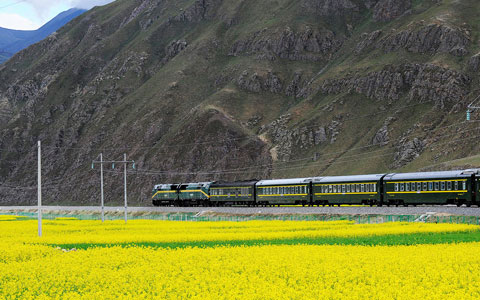 HOT5 Days Lhasa Small Group Tour by Tibet Train
HOT5 Days Lhasa Small Group Tour by Tibet TrainTibet train (from Xining) - Lhasa
Only From: USD599
View Details -
 HOT9 Days Lhasa to Everest Base Camp Small Group Train Tour
HOT9 Days Lhasa to Everest Base Camp Small Group Train TourTibet train (from Xining) - Lhasa - Yamdrok Lake - Gyantse - Shigatse - Everest Base Camp - Dinggye - Sakya - Shigatse - Lhasa
Only From: USD1035
View Details -
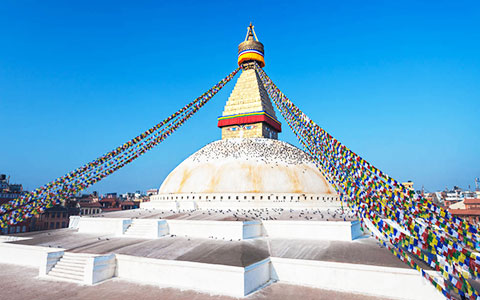 HOT8 Days Lhasa to Kathmandu Overland Small Group Tour with Tibet Train Experience
HOT8 Days Lhasa to Kathmandu Overland Small Group Tour with Tibet Train ExperienceTibet train (from Xining) - Lhasa - Shigatse - Everest Base Camp - Gyirong Border - Kathmandu
Only From: USD1055
View Details -
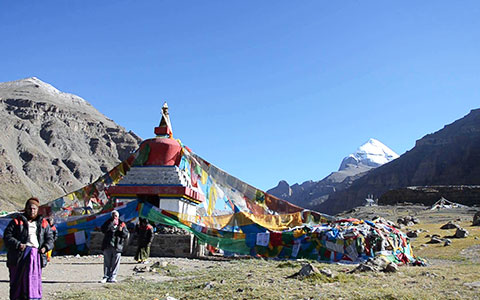 HOT16 Days Kailash and Manasarova Small Group Tour by Tibet Train
HOT16 Days Kailash and Manasarova Small Group Tour by Tibet TrainTibet train (from Xining) - Lhasa - Gyantse - Shigatse - EBC - Saga - Lake Manasarovar - 3 Days Kailash Trek - Saga - Shigatse - Lhasa
Only From: USD2136
View Details
 BACK
BACK
0 Comment ON "Tibet Railway"